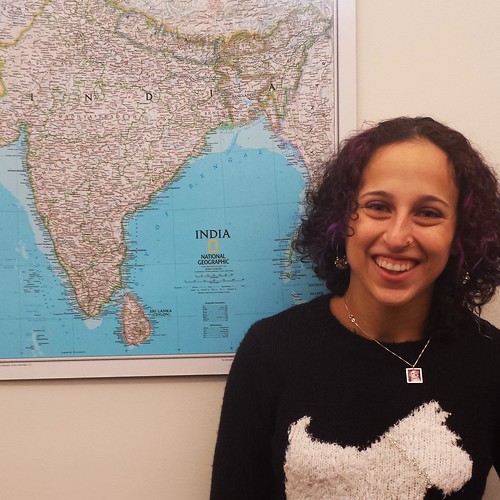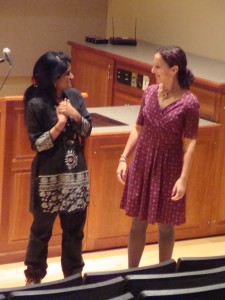In this installment of the Glocal Notes faculty and staff interview series, get to know Mara Thacker, the South Asian Studies librarian at the International and Area Studies Library. Mara is responsible for growing our South Asian studies collection, meeting with patrons with research related to the region, and supervising the library’s graduate assistants. She joined the library in 2012 and has already started on several major projects, including this year’s Indian Film Festival and the South Asian Comic collection, in addition to her day-to-day activities.

Mara Thacker, the South Asian Studies librarian at the International and Area Studies Library.
Tell us a little bit about your background. Where did you grow up? What languages do you speak? Where did you go to school?
I grew up in exotic Richmond, VA and didn’t stray too far from there for undergrad. I went to the College of William and Mary where I studied Indian popular film (technically my degree is in Literary and Cultural Studies) and got a minor in Religious Studies. Being virtually unemployable with that particular degree, I went straight to graduate school at the University of North Carolina Chapel Hill. Thanks to the FLAS scholarship, I was able to continue to study South Asia and also begin intensive Hindi language training. By the time I received my MSLS in 2010 I had spent almost 9 months in India (spread out over several semesters) and attained a working-level proficiency in Hindi.
What attracted you to librarianship and your area of specialty?
I have loved libraries ever since I was a child and thought it might be fun to work in one. I interviewed a few librarians to find out what their jobs were like and that confirmed it for me so I applied to UNC and left the rest to fate. When I started library school I didn’t even know subject specialists existed but then someone told me about the South Asian Studies Librarian at Duke, Avinash Maheshwary, and I got really excited about the idea of being able to continue to study South Asia and also work in a library. Avinash became my mentor and taught me a lot over my time at UNC and now here I am, happy to be the South Asia subject specialist at UIUC.
What are you most excited about working on here at the International and Area Studies Library?
My favorite projects so far have been the Indian Film Festival, which will wrap up on December 10th and then the South Asian comic collection which is ongoing. I really love any projects that involve the public service side of librarianship, so anything involving instruction and outreach is going to be enjoyable for me.
Briefly, describe your typical work day at the library.
I think every day is a little bit different for me—which is just the way I like it! Some common features however are keeping up with email correspondence, attending meetings, working on my research projects, and perusing book lists from vendors to see what I might like to buy for the library.
What are your research and collection development interests within your subject specialty?
I’m still working on developing a cohesive statement on my research agenda, but I can safely say that it will fit under the umbrella of area studies librarianship with a probable slant towards collection development. I’m currently working on a group project looking at the impact of Less Commonly Taught Languages collections and a solo project on the collecting practices of South Asia subject specialists. In terms of collection development interests, I am very excited about building the South Asia comic collection and also enjoy buying films for the library. Otherwise, I try to tailor my purchases to the research and teaching interests of our faculty and students.
Tell us about a cool resource at IAS that you want everyone to know about.
Did I mention the South Asia comic collection? It’s not technically housed in IAS and we’re still working on getting a lot of it on the shelves, but it is really cool. You can get more information from our LibGuide.
(Note: You can also learn more about the South Asian comic collection by checking out this post from the Glocal Notes archive.)
What are some of your proudest career accomplishments?
I’m still pretty early in my career so honestly it still feels like an accomplishment just to have landed my “dream job” as a South Asia subject specialist. That said, I am proud of how the Indian Film Festival turned out, think I did a good job on my first buying trip to India this past February, and was pleased to receive notice that I am going to be nominated for election to the executive board of the Committee on South Asian Libraries and Documentation, which is the professional organization for South Asia subject specialists.
Do you have any career advice for someone interested in the kind of work that you do?
Yes—get on the CONSALD listserv, learn a South Asian language (Hindi/Urdu especially), and get as much practical work experience either as a GA, hourly or practicum student as humanly possible.
Outside of work, what are your hobbies and interests?
I love dancing—especially West African dance and belly dance! I perform with a local belly dance troupe, the Gypsy Hips, and also perform with the Mara Giri Ensemble which is the local West African performance group. I’m looking into starting my own belly dance/West African fusion group which will be called the Faré Xobe Project. Other than that I like to spend time with my dog, Max and eat (not necessarily cook) Indian food.
What is your favorite thing to do in the C-U area?
West African dance classes at the Channing-Murray Foundation!
What is your favorite place you’ve visited?
India! I have a hard time narrowing it down to a specific city in India, but I can say that I have a slight preference for Southern India. I spent a semester in Pondicherry (now Puducherry) and that is a pretty fantastic place, but I also had a really great time in Chennai, Mumbai, Anjuna Beach, Cochin and doing the pilgrimage at Tirupathi.
Do you have a favorite author or authors?
Too many to count! But to name a few: Jhumpa Lahiri, Chitra Banerjee Divakarui, Khushwant Singh, Gita Mehta, Chris Bohjalian, Barbara Kingsolver, and Maggie Stiefvater (this is my YA guilty pleasure). For specific books I also loved “The Art of Racing in the Rain” by Garth Stein, “Veronika Decides to Die” by Paulo Coelho, and “The Hunger Games” trilogy by Suzanne Collins.
This year Mara is having office hours on Fridays from 9 am – 11 am in her office in Room 331of the Main Library (directly across from the International and Area Studies Library). You can also email her at mthacker@illinois.edu with any questions or to schedule an appointment.



